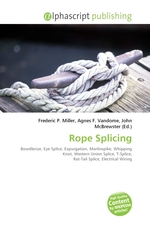Rope Splicing
Frederic P. Miller, Agnes F. Vandome, John McBrewster
бумажная книга
Please note that the content of this book primarily consists of articles available from Wikipedia or other free sources online. Rope splicing in ropework is the forming of a semi-permanent joint between two ropes or two parts of the same rope by partly untwisting and then interweaving their strands. Splices can be used to form a stopper at the end of a line, to form a loop or an eye in a rope, or for joining two ropes together. Splices are preferred to knotted rope, since while a knot reduces the strength by as much as 40% or more, some splices can retain up to 95% of the strength of the line. However, splicing usually results in a thickening of the line and if subsequently removed a distortion of the rope. Most types of splices are used on 3 strand rope, but some can be done on 12 or greater strand braided rope. back splice (also called an end splice) - A splice where the strands of the end of the rope are spliced directly back into the end without forming a loop. It is used to finish off the end of the rope to keep it from fraying. The end of the rope with the splice is about twice the thickness of the rest of the rope.
Данное издание не является оригинальным. Книга печатается по технологии принт-он-деманд после получения заказа.


